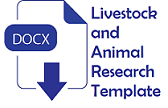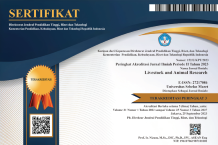Utilization of Indigofera (Indigofera zollingeriana) leaf meal in the ration on chemical meat composition, carcass and non-carcass production, and feces-derived methane yield of male growing rabbit
Abstract
Objective: The aim of this study were to evaluate the inclusion of Indigofera leaf meal (ILM) in the ration on the carcass and non-carcass production, meat chemical composition and feces-derived methane yield of New Zealand White (NZW) rabbits.
Methods: Twenty eights male NZW rabbits with initial body weight of 1455.25 ± 142.41 g, and 65-70 d old were used in this study. There were four treatments namely basal feed (T0); inclusion 4% (T1); 8% (T2), and 12% of ILM (T3) in the ration. The ration was made in form of pellet, and iso-protein that containing 16% of crude protein (CP). The observed variables were carcass and non-carcass production, meat nutrient content and feces-derived methane production.
Results: The study result showed that inclusion of ILM in the rabbit ration up to 12% gave no significant effect (P>0.05) on the carcass and non-carcass production, nutrient content of the rabbit meat (CP, extract ether, moisture and ash) both in Longissimus dorsi (LD) and Bicep femoris (BF) muscles. The moisture concentration in LD muscle showed lower than that in BF muscle, while EE content of LD was higher than that in BF muscle. The result also showed that the incorporation of ILM in the ration up to 12% gave no significant effect (P>0.05) on the methane production of rabbit feces.
Conclusions: The treatments gave no impact on the observed variables. Therefore, ILM can be used as a protein source in male growing rabbit ration at least up to 12%.
Keywords
Full Text:
PDFReferences
- Gidenne, T., and L. Maertens. 2016. Feed efficiency in rabbit production: Nutritional, technico-economical and environmental aspects. 11th World Rabbit Congress, Qingdao, China. Jun. pp: 337-351.
- Sinurat, A. P., T. Purwadaria, P. P. Ketaren, and T. Pasaribu. 2014. Substitutions of soy bean meal with enriched palm kernel meal in laying hens diet. J. Ilmu Ternak dan Vet. 19(3): 184-92.
- Bovera, F., R. Loponte, M. E. Pero, M. I. Cutrignelli, S. Calabrò, N. Musco, G. Vassalotti, V. Panettieri, P. Lombardi, G. Piccolo, C. Di Meo, G. Siddi, K. Fliegerova, and G. Moniello. 2018. Laying performance, blood profiles, nutrient digestibility and inner organs traits of hens fed an insect meal from Hermetia illucens larvae. Res. Vet. Sci. 120: 86-93. Doi: 10.1016/j.rvsc.2017. 04.017
- Abdullah, L. 2017. Herbage production and quality of shrub Indigofera treated by different concentration of foliar fertilizer. Media peternakan. 4: 169-175. Doi: 10.5398/ medpet.2010.33.3.169
- Oseni S. O., and S. D. Lukefahr. 2014. Rabbit production in low-input systems in Africa: situation, knowledge and perspectives – A review. World Rabbit Sci. 22:147-160. Doi: 10.4995/wrs.2014.1348
- Hernàndez, P., A., and D. Zotte. 2010. Influence of diet on rabbit meat quality. In: Nutrition of the rabbit. Edited by C. de Blas, Univesidad Poletenica, Madrid. pp 163-178.
- Philippe F-X, and B. Nicks. 2015. Review on greenhouse gas emissions from pig houses: productions of carbondioxide, methane and nitrous oxide by animals and manure. Agric. Ecosyst. Environ. 199: 10-25. Doi: doi. org/10.1016/j.agee.2014.08.015
- Møller H. B, V. Moset, M. Brask, and M. R. Weisbjerg. 2014. Feces composition and manure derived methane yield from dairy cows:Influence of diet with focus on fat supplement and roughage type. Atmosp. Environ. 94: 36-43. Doi: doi.org/10.1016/j. atmosenv.2014.05.009
- IPCC. 2006. Emission from livestock and manure management. In IPCC Guidelines for National Greenhouse Gas Inventories., vol. 4, Agriculture, forestry and land use. Kagawa, Japan, pp 10.76-82.
- Sanjib R, C. S. Chatterjee, and C. S. Chakrabarti. 2013. Antiproliferative activity of allelochemicals present in aqueous extract of Synedrella nodiflora (L.) gaertn. in apical meristems and wistar rat bone marrow cells. IOSR J. Pharm. 3(2): 1-10.
- Brahmantiyo, B., H. Nuraini, D. Rahmadiansyah. 2017. Produktivitas karkas kelinci Hyla, Hycole dan New Zealand White. Pros. Semin. Nas. Teknologi Peternak. dan Vet. BPT Ciawi, Bogor. 616-626.
- Bhatt, R. S., A. R. Agrawal, and A. Sahoo. 2017. Effect of probiotic supplementation on growth performance, nutrient utilization and carcass characteristics of growing Chinchilla rabbits. J. Appl. Anim. Res. 45(1): 304-309. Doi: doi.org/10.1080/09712119.2016.1174126
- Kandel, T. P., S. Sutaryo, H. B. Møller, U. Jørgensen, and P. E. Lærke. 2013. Chemical composition and methane yield of reed canary grass as influenced by harvesting time and harvest frequency. Bioresource Technology. 130: 659-666. Doi: dx.doi.org/10. 1016/j.biortech.2012.11.138
- Sutaryo, S., A. N. Sempana, C. M. S. Lestari, and A. J. Ward. 2020. Performance comparison of single and two-phase biogas digesters treating dairy cattle manure at tropical ambient temperature. Trop. Anim. Sci. J. 43(4): 354-359. Doi: doi.org/10.5398/tasj.2020. 43.4.354
- AOAC. 2019. Official methods of analysis (21th Ed). Association of official analytical chemist Inc. Maryland.
- Syaichurrozi, I. 2018. Biogas production from co-digestion Salvinia molesta and rice straw and kinetics. Renew. Energ. 115: 76-86. Doi: doi.org/10.1016/j.renene.2017.08.023
- Gomez K. A., and A. A. Gomez. 2007. Prosedur statistic untuk penelitian pertanian. Translated by Sjamsuddin E and Baharsjah JS. UI Press, p. 25–31.
- Sutaryo S., A. Jannah, A. Rizqi, D. Lestari, dan A. Purnomoadi. 2021. Produksi karkas, nilai gizi dan profil asam lemakdaging serta produksi limbah kelinci New Zealand White akibat penyertaan rumput laut cokelat (Sargassum sp.) pada ransum. Lives. Anim. Res. 19 (1): 120-129. Doi: doi.org/ 10.20961/lar.v19i1.45375
- Wahyono T, S. Sadarman, T. Handayani, A. C. Trinugraha, dan D. Priyoatmojo. 2021. Evaluasi performa karkas kelinci lokal dan new zealand white jantan pada berat potong yang berbeda. Jurnal Peternakan. 18(1): 51-60. Doi: dx.doi.org/10.24014/jupet.v18i1:11523
- de Lima, D. M, F. F. R. de Carvalho, F. J. S. da Silva, A. H. N. Rangel, L. P. Novaes, and G. D. D. Difante. 2016. Intrinsic factors affecting sheep meat quality: a review. Rev. Colomb. Cienc. Pecu. 29: 3-15.
- Al-Dobaib, S. N. 2010. Effect of diets on growth, digestibility, carcass and meat quality characteristics of four rabbit breeds. Saudi J. Biological Sci. 17:83-93. Doi: doi.org/ 10. 1016/j.sjbs.2009.12.012
- Paci G., G. Preziuso, M. D. Agata. C. Russo, and A. Dalle Zotte. 2013. Effect of stocking density and group size on growth performance, carcass traits and meat quality of outdoor-reared rabbits. J. Meat Sci. 93: 162-166. Doi: doi.org/10.1016/j.meatsci. 2012.08.012
- Maharani P, N. Suthama, dan H. I. Wahyuni. 2013. Massa kalsium dan protein daging pada ayam arab petelur yang diberi ransum menggunakan Azolla microphylla. Anim. Agric. J. 2(1):18-27.
- Soeparno. 2009. Ilmu dan Teknologi Daging. Penerbit Universitas Gadjah Mada, Yogyakarta.
- Brahmantiyo B, M. A. Setiawan, and M. Yamin. 2014. Physical and chemical properties of rex and local rabbit’s (Oryctolagus cuniculus) meat. J. Peternak. Indonesia. 16(1): 1-7. Doi: doi.org/10.25077/jpi.16.1.1-7.2014
- Ariana, I. N., and A. A. Oka. 2016. Komponen kimia daging di lokasi otot yang berbeda pada sapi Bali yang digembalakan di area tempat pembuangan sampah. J. Peternakan Tropika. 4(3):590-602.
- Dewi, A. M., I. B. N. Swacita, and N. K. Suwiti. 2016. Pengaruh perbedaan jenis otot dan lama penyimpanan terhadap nilai nutrien daging sapi Bali. Buletin Veteriner Udayana. 8 (2): 135-144.
Refbacks
- There are currently no refbacks.










